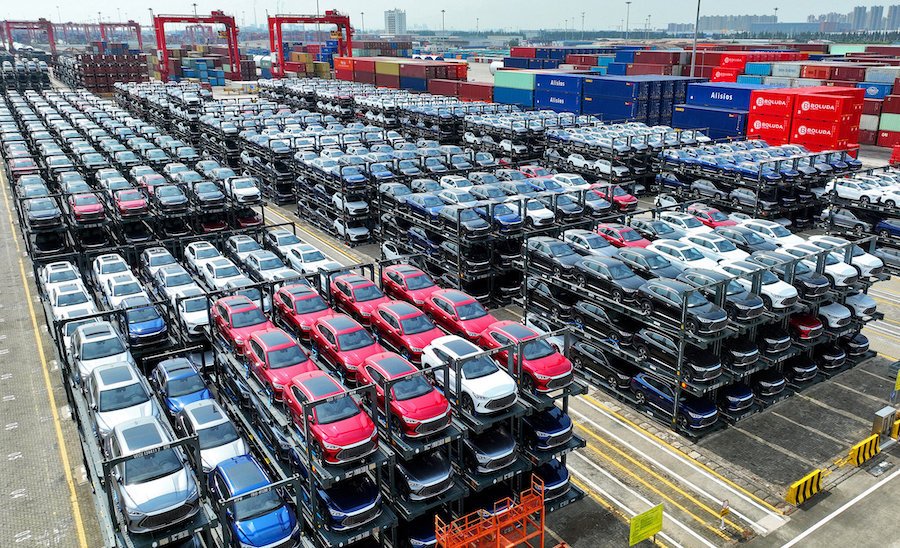Chinese Brands Will Sell A Third Of The World's Cars By 2030: Study

After being largely irrelevant on the global stage historically, Chinese car companies are coming to eat the world’s lunch. That’s not exactly news at this point; President Joe Biden’s steep new tariffs announced in May thrust the meteoric rise of China’s electric vehicle industry into the mainstream conversation.
But we’re learning more and more about the threat that cheap and high-tech Chinese EVs pose to established players like Ford, General Motors, Volkswagen and even Tesla. A new report from the consulting firm AlixPartners projects that Chinese automakers will gobble up 33% of the global car market by 2030, up from around 21% today. Put simply, one in three cars sold in 2030 will come from a Chinese brand, up from one in five today.
That’s an alarming trend for incumbent manufacturers who’d rather expand their market share than watch it erode. And the experts at AlixPartners say legacy automakers need to change their ways fast or risk descending into irrelevance. (Of course, as a consulting firm that does business with car companies, AlixPartners has a horse in this race too. But it isn't the only source saying this.)
“Automakers expecting to continue operating under business-as-usual principles are in for more than just a rude awakening—they are headed for obsolescence,” Andrew Bergbaum, global co-leader of AlixPartners’ automotive and industrial practice, said in a statement. “The revolution taking place in the global auto industry is driven by the incredible and once unthinkable maturation of Chinese automakers that do a number of things differently.”
A lot of that growth will happen in the enormous Chinese market, where homegrown manufacturers have been edging out European and American players for years. But Chinese car companies are gearing up for serious global expansion too. Outside of China, their share of vehicle sales will rise from 3% this year to 13% in 2030, AlixPartners says. To put China’s epic rise into perspective, in recent years the country leapfrogged over Germany and Japan to become the world’s top vehicle exporter.
So what exactly do Chinese automakers do “differently” that gives them such an edge going forward? There’s a lot to it, but let’s highlight a few of the big ones.
China has spent at least a decade investing heavily in its EV industry and everything that supports it—from battery manufacturing to lithium refining to mining. That’s catapulted Chinese automakers far ahead of the competition when it comes to both EV cost and technology.
In the U.S., EV prices remain stubbornly high, because EVs are a relatively new technology and manufacturers apart from Tesla haven’t reached meaningful economies of scale yet. Chinese car companies have blown past that problem. According to AlixPartners, Chinese brands enjoy a 35% cost advantage over other manufacturers thanks to lower labor costs and intense vertical integration (in areas like batteries). Experts also note that Chinese firms have received far more generous subsidies than their Western counterparts. From 2009 to 2023, the Chinese government lavished nearly a quarter-trillion dollars on EVs, according to research from the Center for Strategic and International Studies.
For proof of this cost advantage, look no further than the BYD Seagull, a small hatchback that retails for right around $10,000 in China and has left U.S. auto experts gobsmacked by its solid build quality. Since they can build cars so cheaply, Chinese manufacturers may be able to eat import tariffs in Europe and elsewhere, AlixPartners notes.
Chinese brands also put a greater emphasis on in-cabin technology and design, the firm says. Consider the Zeekr X, which delivers a sliding touchscreen, self-closing doors and a refrigerated center console—all for around $30,000 in China. Tesla pioneered the sprawling iPad-like vehicle touchscreen. Chinese firms have taken that blueprint and run with it.
Plus, Chinese companies iterate on their products extraordinarily quickly, keeping things fresh for consumers. They develop new models about twice as fast as traditional manufacturers do—in 20 months versus 40 months, according to AlixPartners. Some electric-only Chinese brands refresh existing models every 1.6 years on average. In the U.S., models receive a mid-cycle update around every three years, with full redesigns every six years or so.
Moreover, Chinese legacy manufacturers and EV startups dish out over-the-air software updates much more frequently than their global rivals, adding features and tweaks over time. Old-school carmakers are trying to make their vehicles more like smartphones on wheels, but that’s been slow-going.
In Europe and South America, Chinese brands are already a major presence. But here in the U.S., we won’t feel or see China’s rising dominance nearly as much as some other parts of the world will.
Between 2024 and 2030, AlixPartners projects that the Chinese share of North American car sales will rise from just 1% to 3%. (Today, the U.S. only gets a few Chinese imports, including the Polestar 2 EV, a Buick, a Lincoln and a Volvo.) Jacking up tariffs from 25% to 100% will do that. And, of course, the point of the policy was to shield American manufacturers and keep highly competitive Chinese products at bay.
The big question is this: Will tariffs and geopolitical tensions mean that U.S. car buyers just miss out on all the most high-tech, stylish, interesting and low-priced EVs the rest of the world gets access to? Or will the China threat force the rest of the car industry to shape up and get on its level?
